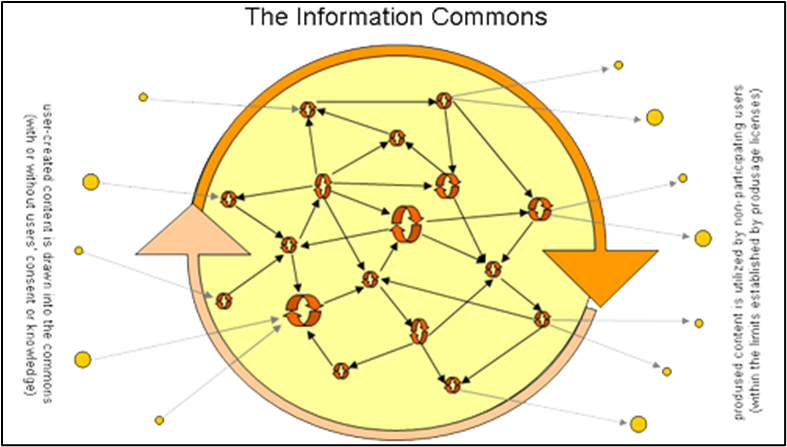Public Relations in a Hyper-Connected World
Public
Relations in a Hyper-Connected World
Written by Grace McGregor
30/05/25
The public relations profession, often misunderstood and at
times maligned, stands at a crucial juncture in the 21st century. As the world
continues to grow and evolve, contemporary PR practitioners navigate a complex
landscape shaped by rapid technological advancements, evolving media
consumption habits, and an increasingly discerning global public. This blog
post will critically analyse five core concepts within public relations through
a theoretical lens, demonstrating their practical application in today's
hyper-connected world.
 |
Figure 1: Produsage Diagram |
Jürgen Habermas's concept of the public
sphere envisioned a space for debate, ideally fostering informed public opinion
For instance, consider the impact of X (formerly Twitter)
during a major news event. While it can facilitate immediate information
sharing and foster collective action, it also becomes a breeding ground for
rumour and unverified claims
The agenda-setting theory, posited by Maxwell McCombs and
Donald Shaw, suggests that the media doesn't tell us what to think, but rather
what to think about
Take, for instance, the spread of health information during
a pandemic. While reputable news organisations report on official guidelines,
algorithms on social media might inadvertently amplify misinformation or
alternative viewpoints, based on user engagement metrics rather than factual
accuracy
George Gerbner's cultivation theory argues that prolonged
exposure to media, particularly television, shapes our perceptions of reality
Framing theory, as explored by scholars like Erving Goffman
and Robert Entman, suggests that the way information is presented, or
"framed," significantly influences how it is interpreted by an
audience
Think about the
differing frames used to describe economic policies. One political party might
frame a tax cut as "stimulating the economy and creating jobs," while
an opposing party might frame it as "benefiting the wealthy at the expense
of public services." Both might be factually accurate in their
descriptions, but the chosen frame elicits distinct emotional and cognitive
responses. In public relations, this means carefully selecting language,
metaphors, and visual cues to present an organisation or issue in a desired
light
Figure 2: Framing Theory in Action |
Everett
Rogers's diffusion of innovations theory explains how new ideas, practices, and
products spread through social systems
Consider the rapid adoption of contactless payment systems
or electric vehicles. Public relations campaigns for such innovations don't
just target a broad audience; they strategically aim to influence different
adopter categories
The public relations profession in the global media
landscape is undeniably dynamic and multifaceted. As demonstrated through the
critical analysis of the public sphere, agenda-setting, cultivation, framing,
and diffusion of innovations, PR practitioners must possess a sophisticated
understanding of communication theories to effectively navigate the
complexities of contemporary global media and communication. Beyond publicity,
successful public relations in the 21st century demands a
theoretical grounding that informs strategic engagement, fosters genuine
dialogue, and contributes to shaping a more informed and engaged public.
References
Anderson, A. (2009). Media, politics and climate
change: Towards a new research agenda. Sociology Compass.
Bruns, A. (2018). Gatewatching
and News Curation: Journalism, Social Media, and the Public Sphere.
Chadwick, A.
(2013). The Hybrid Media System: Politics and Power. Oxford University
Press.
Chong, D. &.
(2007). Framing theory. Annual Review of Political Science.
Dearing, J. W.
(2018). Diffusion of Innovations Theory, Principles, and Practice.
Health Affairs.
Entman, R. M.
(1993). Framing: Toward clarification of a fractured paradigm. Journal
of Communication.
Gerbner, G. G.
(2002). Growing up with television: Cultivation processes. Media
Effects: Advances in Theory and Research.
Gillespie, T.
(2014). The relevance of algorithms. Media Technologies: Essays on
Communication, Materiality, and Society: MIT Press.
Goffman, E.
(1974). Frame Analysis: An Essay on the Organization of Experience.
Harvard University Press.
Greenhalgh, T. e.
(2004). Diffusion of innovations in service organizations: Systematic
review and recommendations. The Milbank Quarterly.
Habermas, J.
(1989). The Structural Transformation of the Public Sphere: An Inquiry into
a Category of Bourgeois Society. MIT Press.
MacLeod, A. (2020,
September 3). Great example of how powerful media framing can be.
Retrieved from X: https://x.com/AlanRMacLeod/status/1301275702755504129
Matthes, J.
(2009). What's in a frame? A content analysis of media framing studies in
the world's leading communication journals. Journalism & Mass
Communication Quarterly.
McCombs, M. E.
(1972). The agenda-setting function of mass media. Public Opinion
Quarterly.
Morgan, M. S.
(2015). Yesterday’s new cultivation, tomorrow. Mass Communication and
Society.
Napoli, P. M.
(2014). Automated media: Algorithmic media production and the case of the
narrative science. Digital Journalism.
Papacharissi, Z.
(2002). The virtual sphere: The internet as a public sphere. New Media
& Society.
Produsage.org.
(2002, January 2). Picturing Produsage. Retrieved from Produsage.org:
https://produsage.org/node/13
Rogers, E. M.
(2003). Diffusion of Innovations. Free Press.
Tandoc, E. C.,
Lim, Z. W., & Ling, R. (2018). Defining ‘Fake News’: A typology of
scholarly definitions. Digital Journalism.
Tufekci, Z.
(2015). Algorithmic harms beyond Facebook and Google: Emergent challenges
of computational agency. Colorado Technology Law Journal.
Wejnert, B.
(2002). Integrating models of diffusion of innovations: A conceptual
framework. Annual Review of Sociology.

Comments
Post a Comment